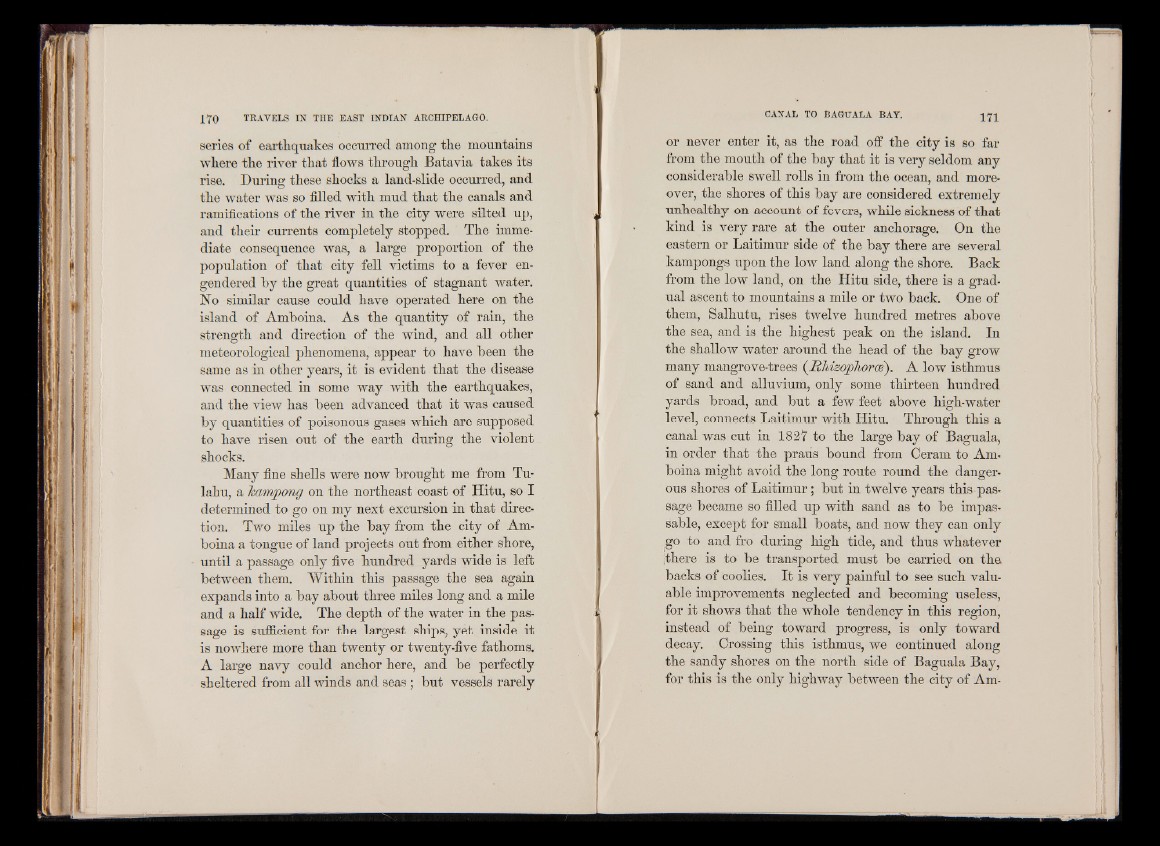
series of earthquakes occurred among the mountains
where the river that flows through Batavia takes its
rise. During these shocks a land-slide occurred, and
the water was so filled with mud that the canals and
ramifications of the river in the city were silted up,
and their currents completely stopped. The immediate
consequence was, a large proportion of the
population of that city fell victims to a fever engendered
"by the great quantities of stagnant water.
No similar cause could have operated here on the
island of Amboina. As the quantity of rain, the
strength and direction of the wind, and all other
meteorological phenomena, appear to have been the
same as in other years, it is evident that the disease
was connected in some way with the earthquakes,
and the view has been advanced that it was caused
by quantities of poisonous gases which are supposed
to have risen out of the earth during the violent
shocks.
Many fine shells were now brought me from Tu-
lahu, a Tcampong on the northeast coast of Hitu, so I
determined to go on my next excursion in that direction.
Two miles up the bay from the city of .Amboina
a tongue of land projects out from either shore,
until a passage only five hundred yards wide is left
between them. Within this passage the sea again
expands into a bay about three miles long and a mile
and a half wide. The depth of the water in the passage
is sufficient for the largest ships, yet inside it
is nowhere more than twenty or twenty-five fathoms.
A large navy could anchor here, and be perfectly
sheltered from all winds and seas ; but vessels rarely
or never enter it, as the road off the city is so far
from the mouth of the bay that it is very seldom any
considerable swell rolls in from the ocean, and moreover,
the shores of this bay are considered extremely
unhealthy on account of fevers, while sickness of that
kind is very rare at the outer anchorage. On the
eastern or Laitimur side of the bay there are several
kampongs upon the low land along the shore. Back
from the low land, on the Hitu side, there is a gradual
ascent to mountains a mile or two back. One of
them, Salhutu, rises twelve hundred metres above
the sea, and is the highest peak on the island. In
the shallow water around the head of the bay grow
many mangrove-trees (Rhizophorce). A low isthmus
of sand and alluvium, only some thirteen hundred
yards broad, and but a few feet above high-water
level, connects Laitimur with Hitu, Through this a
canal was cut in 1827 to the large bay of Baguala,
in order that the praus bound from Ceram to Am.
boina might avoid the long route round the dangerous
shores of Laitimur; but in twelve years this pas-
sage became so filled up with sand as to be impassable,
except for small boats, and now they can only
go to and fro during high tide, and thus whatever
¡there is to be transported must be carried on the
backs of coolies. It is very painful to see such valuable
improvements neglected and becoming useless,
for it shows that the whole tendency in this region,
instead of being toward progress, is only toward
decay. Crossing this isthmus, we continued along
the sandy shores on the north side of Baguala Bay,
for this is the only highway between the city of Am